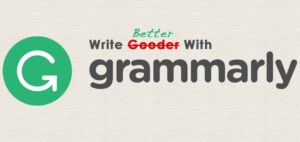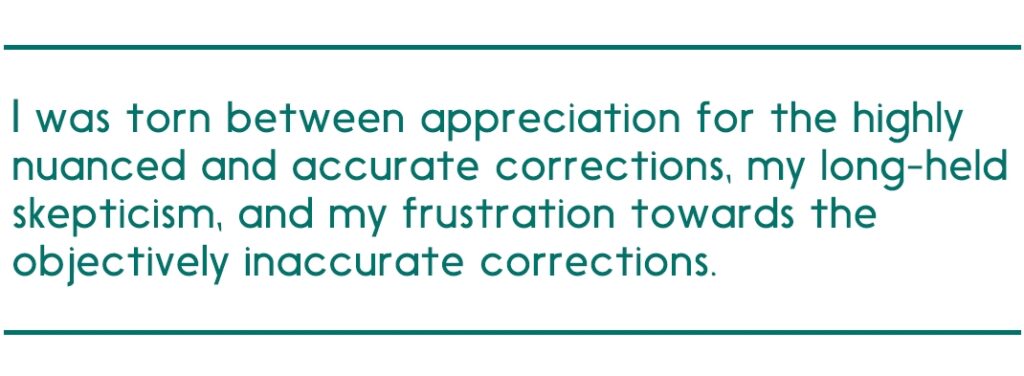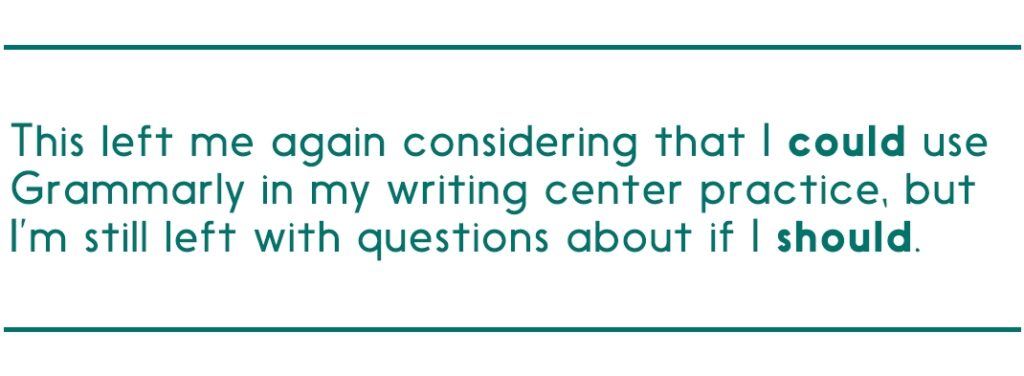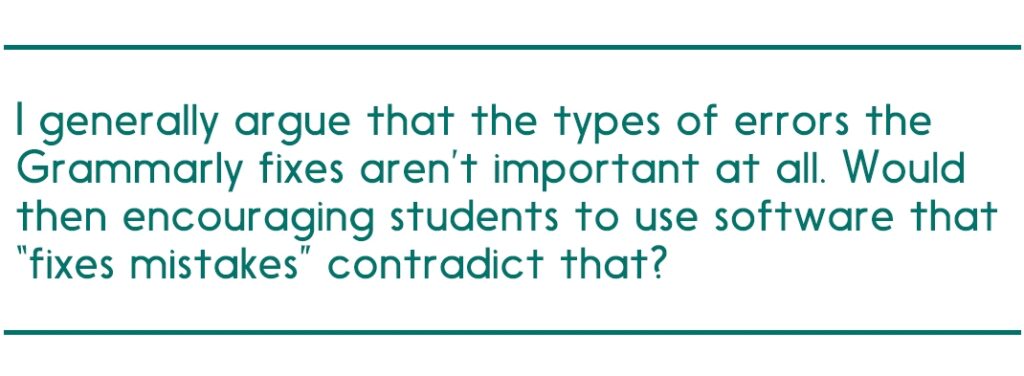By Dorothy Mayne, Faculty Associate in the Writing Center
As I entered the Undergraduate Library at the University of Illinois at Urbana-Champaign for my shift as a tutor in the writing center one day in the fall of 2015, I noticed a new and overwhelming number of flyers and posters for Grammarly, the automated written corrective feedback (AWCF) software. As the flyers purported, students could use Grammarly to help “perfect” their writing. The flyer showed how you could copy and paste your writing into Grammarly, and it would point out and correct the grammar, spelling, and punctuation errors. These flyers were on all the bulletin boards, in stacks on all the common area tables, and tacked up on the walls. There was even one big poster right outside the door of the writing center and a stack of promotional postcards on the writing center’s reception desk.

This Grammarly banner comes from a 2015 Grammarly promotional event for UW-Madison students on Facebook.
When I was growing up in a rust-belt city that started losing manufacturing jobs to automation in the 80s, the adults around me always advised me to pursue a career that “won’t be replaced by a machine.” This was advice that I took to heart and contributed to my decision to study Teaching English to Speakers of Other Languages (TESOL) in college. Looking at this Grammarly promotion that suggested AWCF could “help perfect your writing,” I felt a glimmer of fear that my work, or at least part of it, and in the minds of some, could be replaced by a machine. I imagined different colleges across campus advocating for replacing English language courses with software and plenty of other hyperbolic scenarios that hinged on equating writing instruction and support with final-product editing.

I went to the Grammarly website to set my worries to rest. I was sure that it wouldn’t be able to catch errors in idiomatic phrases, collocation, and articles–and surely it would have just as many faulty corrections as correct ones. At the time, you copied and pasted your text into the grammar checker on the Grammarly website. I played around with different texts and wrote sentences with common grammar issues that I encountered in my work at the writing center to see what kinds of corrections Grammarly offered. Many of the corrections were simply wrong, and some weren’t wrong but could be more confusing than helpful. My fear of being replaced by a machine was quickly assuaged. Grammarly’s feedback was so flawed. Occasionally students would ask me about Grammarly, but I would tell them that it might do more harm than good. I continued to provide writing support that didn’t include room for corrective software at the final editing stage.
It’s many years later, and I’m now a Faculty Associate with UW-Madison’s Writing Center. In my work and personal communications, automated written corrective feedback (AWCF) software seems to be everywhere I type. It offers me feedback as I draft emails in the web version of Outlook, collaborate on drafts in Google Docs, and elsewhere (whether I want corrective feedback or not). According to its website, Grammarly now has 30,000,000+ daily users, is licensed by 1000+ educational institutions, has free extensions for web browsers so that it can give feedback on writing any text field (e.g., in Canvas message boards, Tweets, etc.) as it’s being written, and has a Microsoft Word plug-in. It also now has services and features for more global concerns including a “tone detector.” An October 2020 product update suggests the Grammarly Premium “helps multilingual English speakers write more fluently.”
In the more than five years that have passed since the last time I considered Grammarly, I thought maybe it had improved greatly, so I decided to give it another try. This time I was not worried about being replaced. Instead, I was hopeful that I could find a tool to share with students who have concerns about lower-order concerns as they do final edits. I tried Grammarly with some text that I had recently written, and it found 15 errors that Microsoft Word’s grammar checker didn’t find, most of which were accurate corrections.
Here are some examples of some of the recent corrections Grammarly has given me. The inaccurate corrections are most often with articles and punctuation, as represented here. The accurate corrections on my writing are most often typos related to missing or double words, also represented here.

This screenshot shows Grammarly inaccurately suggesting a comma after “safety” in the phrase “safety and security.”

This screenshot shows Grammarly inaccurately suggesting to add “the” before “language” in the phrase “the feature of language,” which is inaccurate because it was referring to language in general, and there is already an article before “feature.”

This screenshot shows Grammarly inaccurately suggesting to add “an” before “example,” which is inaccurate because example is used as a modifier of “portfolios,” not a noun that needs an article.

This screenshot shows Grammarly suggesting an accurate edit (adding “as” to “…seen *as* a low priority,” but it identifies this as a preposition error when it’s an issue of a missing word.

This screenshot shows Grammarly suggesting an accurate edit to remove a typo where I have the same two words twice in a row. Microsoft Word did not catch this typo.

The beta “Tone Detector” gave me 5/5 for being friendly, optimistic, and formal (not that it knew anything about my rhetorical situation, but that was accurate to my goal). I was torn between appreciation for the highly nuanced and accurate corrections, my long-held skepticism, and my frustration towards the objectively inaccurate corrections.
I decided that it was worth deeply considering how Grammarly (and other AWCF software) was being used (if at all) in writing centers, what scholarly research is saying about Grammarly, what its users think and, potentially, how it could be useful in my writing center practice.

Recent Research about Grammarly
Recent research about Grammarly highlights that it can be a useful but imperfect tool. Dembsey’s (2017)[1] research addressed Grammarly’s now-replaced marketing that it could “help perfect your writing” and interrogated how Grammarly marketed itself to writing centers in 2014, as I saw in my previous work at University of Illinois at Urbana-Champaign’s writing center. (Jen Fandel, our Writing Center Administrator, looked into the email archives and found that UW-Madison’s Writing Center received several marketing emails from Grammarly at that time as well). Dembsey expressed concern that Grammarly would prevent already marginalized students from seeking support from the writing center. To critically consider Grammarly’s promises, Dembsey compared Grammarly feedback to asynchronous feedback from writing center consultants and found some clear (if not unsurprising) differences: 1.) WC consultants made fewer comments overall, 2.) WC consultants provided positive feedback (Grammarly does not), 3.) WC consultants’ feedback was often holistic, including considerations for the stage of the writing process (Grammarly’s was not), 4.) both WC consultants and Grammarly provided inaccurate grammar feedback and instruction. Much criticism of Grammarly is based on inaccurate grammar corrections, and this research notes that inaccuracy can be a factor in feedback from humans, too. Much research about Grammarly highlights its differences from human writing feedback, but as Dembsey shows, those differences don’t preclude it from being a valuable tool for those who provide and use writing feedback.
Recent research has explored students’ (especially multilingual writers) perceptions and use of Grammarly. Koltovskaia (2020)[2] presents case studies about how students in a second language writing course used Grammarly to revise drafts of their assignments. She found that Grammarly helped a student who had a lot of experience with English writing to correct errors while implementing rules that the student was already familiar with, but Grammarly feedback overwhelmed another, less experienced student who accepted inaccurate feedback related to rules that weren’t familiar to her. The less experienced student said that she “will just accept the feedback” if she isn’t sure or is unfamiliar with the rule, and she did not read explanations when she wasn’t immediately clear on why something was marked as wrong. When she described her process of working with the feedback, she said, “At the beginning, I was thinking about every mistake. I used to read the sentence from the beginning, think about it a little bit but at the end, I just accepted.” This research suggests that Grammarly can be helpful in allowing students to accurately use feedback that points out mistakes about rules that they already know but implemented incorrectly, but they can also become overwhelmed with the number of corrections recommended. Additionally, when the feedback is about rules that the student isn’t familiar with or when the student is feeling overwhelmed, they’re likely to either ignore it or accept it uncritically. Overall, though, both participants reduced the total number of grammar errors in their drafts using Grammarly, and both saw the benefits in using it while recognizing at the same time that it is imperfect.
Zhang, Ozer, and Bayazeed (2020)[3] specifically explored L2 students’ perceptions of Grammarly versus a writing center appointment. They found that most participants used both Grammarly and the writing center. Participants who used both saw the benefits of each mode of feedback and selected which one to use strategically based on where they were in their writing process (namely, seeking support from the writing center for higher-order concerns and using Grammarly for final paper editing). Participants’ perceptions of the differences between AWCF corrections and feedback provided by writing center consultants were consistent with the differences the Demsbey (2017) found and shows that students use these differences to inform their choice about where to get support.

Despite numerous and well-documented issues (e.g., inaccurate feedback, its potential to overwhelm) with Grammarly, recent research suggests that students understand its limitations and use it strategically to have fewer grammar errors on final drafts. This left me again considering that I could use Grammarly in my writing center practice, but I’m still left with questions about if I should.
Automated Written Corrective Feedback Software and Linguistic Justice
I could discuss many potential issues and negative consequences of AWCF that inform whether or not I think that I should use it in my writing center practice, but its implications for linguistic justice deserve to be center-stage. My work towards linguistic justice, which includes promoting the value of linguistic diversity, is usually in the context of working with multilingual writers. In all my work with students and instructors, I emphasize the fact that there is no one, correct way to say or write something; conventions are context-specific and change over time. Nevertheless, final editing and proofreading are valuable parts of the writing process, and I understand that many readers are distracted by objective errors with lower-order concerns. Not only that, but instructors who are grading student work often have strong preferences about such errors. If software worked well, it could help multilingual writers correct grammar mistakes and have amazing potential to ease the concerns that L2 writers and some of their readers have about minor grammar errors, thus contributing to linguistic justice.
However, considering AWCF at its best (when it provides accurate corrections to grammar and mechanical errors) and ignoring the worst-case scenario (when it provides inaccurate corrections), I have concerns for what this implies for linguistic justice. I teach students to use their own voice, to appreciate writing with an accent, and to understand that even rules that seem to have objective right and wrong are often linked to subjective style. I believe that this is essential to promoting a campus that values linguistic diversity. When I work with instructors, I encourage them to prioritize higher-order writing concerns. When they do consider lower-order concerns, I ask them to interrogate their own biases about what makes “correct” writing. I generally argue that the types of errors the Grammarly fixes aren’t important at all. Would then encouraging the use of software that “fixes mistakes” contradict that? Considering current research on students’ perceptions of Grammarly and how they use it strategically, I think that many students would also be strategic thinking in accepting Grammarly’s corrections for minor objective errors while cultivating their own voice, especially with direct instruction on how and why to interrogate its corrections.

But let’s turn to the worst-case scenario: students can be overwhelmed with Grammarly’s numerous corrections, many of which are inaccurate. Grammarly has the potential to exacerbate multilingual writers’ frustration with low-order grammar concerns and apprehension towards L2 writing. I am concerned about a scenario where a frustrated student reaches their last straw as they sort through numerous, confusing, inaccurate grammar corrections from Grammarly, crushing their belief in their ability to develop their language, persist towards a degree, make social connections in the language, and much more. I am concerned about a scenario where a student who believes that their surface-level errors aren’t important but uses Grammarly for final editing and becomes disheartened when the number of errors Grammarly points out never seems to decrease, giving concrete data to justify their feeling that they just aren’t improving. Research shows that overall participants decreased the overall number of errors on a final draft with Grammarly, but it hasn’t attempted to measure the potential negative impacts on writers, which is much more complicated to measure.
Beyond its application with individual students, Grammarly’s corrections reinforce a rigid and harmful notion of a standard English that’s earned its status through global white supremacy. The participant in Koltovskaia’s (2020) case study who gave up on engaging with Grammarly feedback said that she is motivated to not have errors with lower-order concerns because “[she doesn’t] want a teacher to look at [her] work and immediately tell that [she’s] international.” It’s great if students can feel more confident and provide instructors with writing that has fewer lower-order concerns, and research suggests that students can use Grammarly to reduce their total number of errors. Ultimately, my main concern is dismantling a system that would make a student not want to be identified as international in the first place, but I also regularly work with multilingual writers who are looking for more immediate grammar support.
AWFC and Writing Center Practice
In light of the research and my own concerns for linguistic justice, I don’t think that I would advocate for students who aren’t already using Grammarly to start using it. (Beyond the scope of this blog, there’s also a concern for data privacy that’s worth at least mentioning here.)

However, many students are already using AWCF software (most often Grammarly). So, when working with a student who is concerned about lower-order concerns, I ask them if they are using AWCF software, how they use it, and what their perception of it might be. I consider sharing with them some information about what the research finds about how students use AWCF software strategically for final editing. I caution them about using it to find patterns of error because the feedback so regularly has its own patterns of inaccuracy (e.g., consistently inaccurate feedback about articles and punctuation). I use the “tone detector” as a springboard for conversation about rhetorical situations if I think this could be useful. I do all of this within the affordances of one-on-one writing consultations: individualized dialogue, after all, can’t be replaced by a machine.
I won’t encourage students who aren’t already using Grammarly but who have concerns about lower-order grammar concerns to start using it. Instead, if they are looking for a final editing tool, I will suggest that they try to use the AWCF that is already embedded in Google Docs. Often, since working virtually, I work with students using Google Docs, and I’ve found that its corrections identify typos and grammar errors with a lot of nuance and are much less likely to have inaccurate corrections than Grammarly. It doesn’t offer any information about corrections, but that also means that it never provides inaccurate or confusing information about corrections! I didn’t find any research that explores the use of Google Docs AWCF to reduce the number of errors in final drafts, but in the time that I’ve been using it myself, it seems promising as a less heavy-handed and more accurate alternative to Grammarly.
After falling into this particular Grammarly rabbit hole, I emerged with my existing beliefs and priorities reinforced. The current Grammarly marketing is less incendiary to audiences in fields like Writing Studies and Composition and Rhetoric than it was a few years ago, and the artificial intelligence is improving in its ability to find errors and suggest correct fixes. But it’s still too problematic (both in terms of inaccurate corrections and harmful implications for linguistic justice) for me to integrate into my writing center practice in the ways it’s intended.
Even though this exploration of Grammarly didn’t lead me to have a great tool to share with students, it did inspire me in some ways. This semester, I’m facilitating a new graduate writing group for second language writers, and when we talk about strategies for final editing, we’ll have a discussion about using ACWF strategically. In workshops about grammar conventions, I’ll use examples of Grammarly’s inaccurate corrections to help students critically engage with the rules we cover and explicitly talk about strategic use of ACWF. More importantly, though, I’ll continue to advocate for a broader appreciation of linguistic diversity across campus while also attending to students’ and instructors’ shared desire for reducing grammar errors.
If I could update the Grammarly posters that covered the walls of the library where I worked years ago, instead of promises of perfecting writing, I’d like to see it feature a student’s writing to-do list written in multiple languages and more parts of the writing process, including reading, researching, talking to classmates and instructors, making an appointment with the writing center, revising, and finally using Grammarly to do a final proofreading check.
[1] Dempsey, J.M. (2017). Closing the Grammarly gaps: A study of claims and feedback from an online grammar program. Writing Center Journal, 36(1), 63–96.
[2] Koltovskaia, S. (2020). Student engagement with automated written corrective feedback (AWCF) provided by Grammarly: A multiple case study. Assessing Writing, 44, 1–12.
[3] Zhang, J., Ozer, H.Z., & Bayazeed, R. (2020). Grammarly vs. face-to-face tutoring at the writing center: ESL student writers’ perceptions. Praxis: A Writing Center Journal, 17(2), 1–37.

–
Dorothy Mayne is a Faculty Associate in the Writing Center at UW–Madison, where she teaches workshops, works with students on their writing, and more.


Thank you for sharing your journey down the Grammarly rabbit hole, Dottie! Your reflections and review of the literature have spurred me down paths considering both WC and WAC practice, and have reenergized me for the perennial work along each in shepherding new ways of thinking about the dynamism of language for students and instructors. I’m reminded of Anne Curzan’s chapter in /Fixing English/ on “Checking Grammar and Grammar Checkers,” which analyzes Microsoft Word’s grammar checker, and her overarching contentions about the extent to which prescriptivist software and handbooks influence language use and development as well as language ideology… I share your concerns about linguistic justice and how the socially constructed inputs of “correct” grammar in AWCF works to uphold white language supremacy, and I so appreciate your weighing the question of whether one could and *should* use such software. I want to incorporate, as you do, more explicit discussion about the limitations of the software in my conversations with students and instructors, especially where it can serve as a springboard for conversation about rhetorical situation and higher order concerns–Again, thank you!
Thank you for sharing this wonderful article, and especially for analyzing Grammarly in regards to linguistic justice!
Grammarly’s marketing is very prescriptive. I have seen their ads constantly on YouTube, with actors saying “I had no idea how many mistakes I was making until I tried Grammarly.” And other phrases that attempt to capitalize on people’s feelings of linguistic insecurity. It’s sickening how Grammarly benefits from linguistic insecurity and prescriptivism, and so seeks to plant those ideas with its ads.
I completely agree with your ideas of the harm Grammarly potentially causes, especially to L2 writers’ confidence. Personally, English is my native language and AWCFs are generally a minor annoyance to me, but there have been times (especially writing emails to professors or stressful essays) where correction software sparked great anxiety and linguistic insecurity in me. Using Grammarly would just feed into that. Why should I pay for a service that harms me?
[…] Mayne’s blog about Grammarly […]
[…] to “Revisiting Grammarly” by Dorothy […]
I don’t think Grammarly is any different from Google translate. Both are still insufficient and I don’t think they will be enough anytime soon.
In fact, I would expect such artificial intelligence to be more developed. Language is one of the best and most beautiful ways to express ourselves to others.
We cannot always use our language correctly. We make a lot of spelling mistakes. Ahh.. that’s too bad but true.
With such machines, we need to be able to easily create more accurate sentences. Of course, this seems like a dream for now. I guess they don’t put much effort into it. Hope it will improve in a few years. Hopefully..